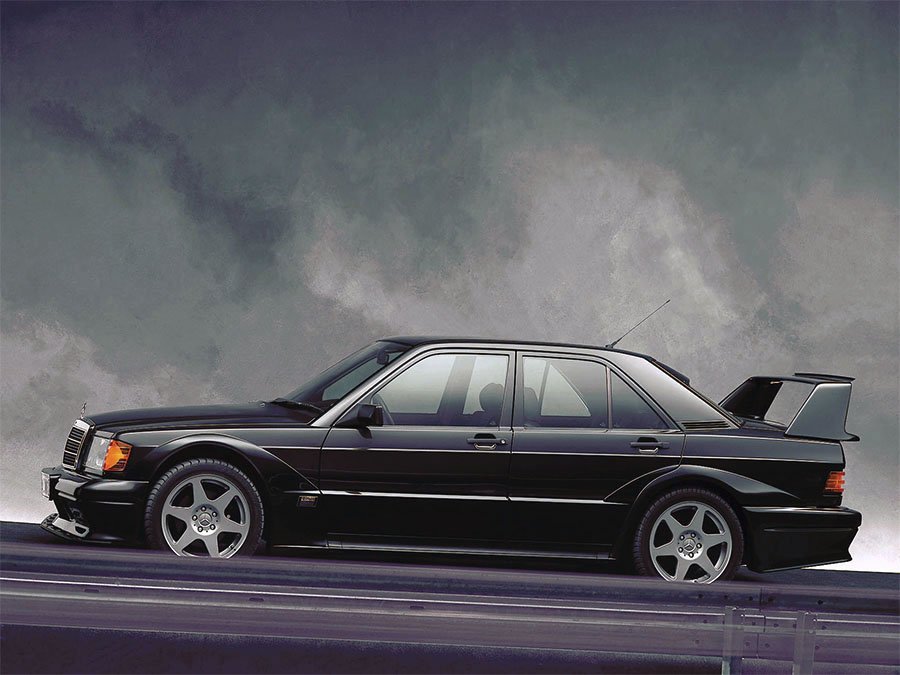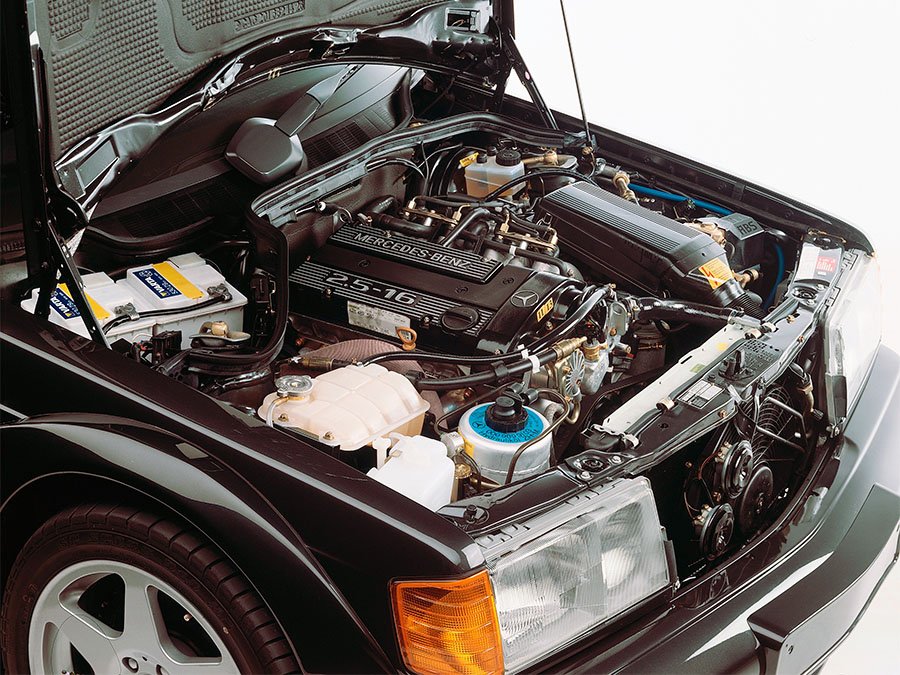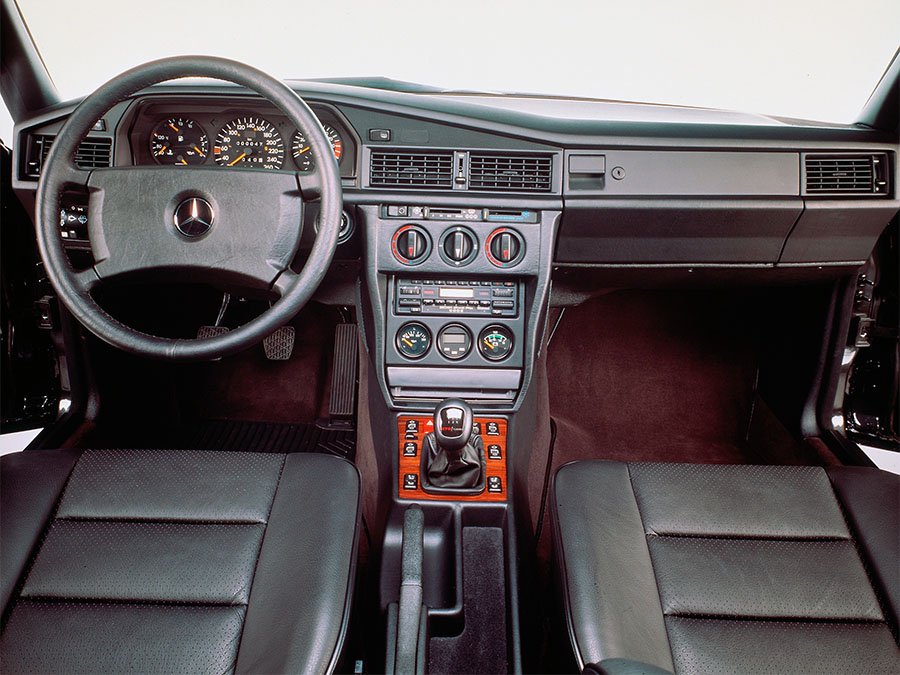Guide: Mercedes-Benz W201 190 E 2.5-16 Evolution 2
Background
Five years after the original Cosworth-tuned 190 E 2.3-16 broke cover at Frankfurt in September 1983, Mercedes got serious about a motor sport programme for the car.
The firm’s initial reluctance to compete with their W201-based hot rod was the result of it having been completely unsuited to Mercedes’ original plan to go Group A rallying; against four-wheel drive opposition, the 190 would have stood no chance.
However, as the 1980s drew to a close, another avenue opened up that became of interest to Mercedes.
Following its inaugural season in 1984, Germany’s domestic touring car championship – the Deutsche Tourenwagen Meisterschaft or DTM (initially the Deutschen Produktionswagen Meisterschaft for ‘84 and ‘85) – had gone from strength to strength. Huge in-person and TV audiences were being drawn to the series which in turn attracted factory-supported teams from some of Mercedes’ biggest rivals.
With several privateer teams having already demonstrated the suitability of the 190 E 2.3-16 in the DTM, Mercedes launched a bigger 2.5-litre version at the Paris Motor Show in September 1988. Once 5000 examples of the new 2.5-16 had been built, an all bells-and-whistles Evolution variant followed at Geneva in March ‘89 to homologate a host of trick parts for that year’s DTM campaign. 500 Evolutions had to be built to secure homologation which Mercedes completed in less than two months.
Unfortunately, although Mercedes won eight of the 22 races contested in 1989, the title went to a BMW driver for the third time in six years.
Although the Evolution 1 had taken the 190 to the limit in some respects, there was still regulatory capacity for improved aero, some additional engine tuning and bigger wheels / tyres.
With this in mind, and determined to wrestle domestic supremacy from BMW, the resultant 190 E 2.5-16 Evolution 2 made its debut at the Geneva Motor Show in March 1990.
As before, a minimum production run of 500 units was required, upon which the race version had to be closely based.
Production began in May 1990.
Bodywork
While the Evolution 1 had come with a deep front spoiler, brawny wheelarch extensions and an adjustable rear wing, the Evolution 2’s fibreglass composite body kit was on another level.
The radical new look was the result of a collaboration between Mercedes’ Rudiger Faul and Professor Richard Lapple from the Stuttgart University of Technology.
At the front was a re-profiled and simplified air-piercing bumper assembly complete with adjustable chin splitter.
Mounted on the trunk was an enormous and most un-Mercedes-like split-level basket handle spoiler with adjustable Gurney flap. The lower portion of the spoiler was fully faired-in with the boot lid and extended well beyond the tail fascia. As racing regulations did not permit the rear spoiler to directly impede vision through the rear windscreen, Mercedes cunningly added a cover at the top of the screen which not only obscured the spoiler from appearing in the mirror, but also re-directed airflow towards the wing.
As per the front, the back bumper assembly was simplified and extended. The lower apron was re-profiled and featured a cutaway to accommodate the new twin-outlet exhaust. As a consequence of the extended bumpers, the Evolution 2 came in 113mm longer than its predecessor.
Fitted underneath the rear bumper assembly was an aluminium panel designed to smooth airflow exiting from underneath the car.
The sides of the bumpers were flared outwards to integrate with massive wheelarch extensions needed to accommodate wider wheels. New skirts and lower cladding for the doors were added as well. An Evolution badge was fixed to the cladding behind each front wheel.
Chassis
Aside from new 17 x 8.25-inch six-spoke alloy wheels shod with Dunlop SP Sport D40 tyres, the Evolution 2’s chassis set-up was carried over from the Evolution 1.
Like all previous iterations of the 2.3-16 and 2.5-16, each Evolution 2 started life as a standard 190 pressed steel bodyshell with 2665mm wheelbase.
Front suspension comprised a MacPherson strut and separate spring arrangement. The back used a five multi-link layout. Anti-roll bars were fitted at either end along with anti-dive and anti-squat geometry.
Harder bushings were fitted than regular 190s along with a self-levelling rear axle, a quick steering rack and a special 70-litre fuel tank (fitted over the rear axle).
A switch in the cockpit allowed the ride height to be adjusted electronically.
Stiffer springs and shocks were imported from the Evolution 1 along with that car’s bigger 300mm front and 278mm rear brakes discs (sourced from the R129 500 SL).
Engine / Gearbox
Instead of the Type M 102 991 inline four cylinder engine fitted to the original Evo, the Evolution 2 came with an M 102 992 motor automatically equipped with the AMG Power Pack and a sports exhaust.
Whereas previous iterations of these hot 190s had been offered with RUF and KAT engines, only one version of the M 102 992 motor was ever fitted to the Evolution 2.
The basic specification of a cast-iron block, DOHC light alloy 16-valve head, mechanical valve lifters, wet-sump lubrication and Bosch multipoint fuel-injection was unchanged. As per the big bore short stroke Evo 1, displacement was 2463cc achieved thanks to a bore and stroke of 97.3mm and 82.8mm respectively.
Significantly, the compression ratio was upped from 9.7:1 to 10.5:1 and the redline was increased from 7250rpm to 7700rpm.
Peak output was now 235bhp at 7200rpm and 181lb-ft at 5000-6000rpm.
For comparison, the outgoing Evolution 1 produced 225bhp at 7200rpm and 177lb-ft at 5500rpm (if optioned with the expensive and rarely seen AMG Power Pack).
Neither the Evolution 1 or Evolution 2 could be ordered with an automatic gearbox (unlike the standard 2.5-16). Instead, only the five-speed manual Getrag dog-leg unit was installed. As per the base model, this had its own oil cooler.
Transmission was through a single plate clutch and Mercedes’ electronically controlled Anti-Slip Differential (ASD).
ASD was a hydraulically locking differential that maximised traction. The electronic control allowed varied amounts of differential lock from the standard 15% right up to 100%. However, it was not a traction control system in that it did not prevent wheel spin. Activation of the ASD system was indicated by an illuminating amber triangle housed within the speedometer.
Interior
Inside, each Evolution 2 came with an individually numbered gear lever insert.
Otherwise the specification was carried over from the standard 2.5-16 and Evo 1.
Compared to regular 190s, these cars came with a small diameter leather steering wheel, a custom rev counter, a series of extra centre console-mounted gauges and more heavily bolstered sports seats (front and back).
Behind the four-spoke steering wheel was a curved instrument binnacle that was neatly integrated with the rest of the dash. A large speedometer was flanked to the right by a slightly smaller rev counter inset with an analogue clock. To the left was a combined gauge for fuel level, water temperature, oil pressure and fuel economy.
Three additional read outs (an ammeter, digital stop watch and oil temperature gauge) were housed in the centre console underneath the ventilation controls and audio system.
All cars came with a Zebrano wooden insert for the transmission console.
Black leather was used to upholster the seat bolsters. The seat centres were trimmed in checked fabric to match the door panels. A mix of hard-wearing soft-touch black plastic and vinyl was used pretty much everywhere else.
As per most Mercedes of this era, the standard equipment level was quite basic.
Options
Like the Evo 1, only one colour scheme was officially offered: Blue-Black Metallic. However, two cars destined for VIP customers were reputedly finished in different colour schemes.
Optional extras included anti-lock brakes, leather upholstery, front axle lift, air-conditioning, electric windows (front only or front and rear), an electric sunroof, tinted glass, an outside temperature gauge, driver airbag, electric aerial, rear headrests, headlight wash/wipe, a higher capacity battery and rear speakers.
Buyers could also specify electric front seats, electric front seats with memory function or electric heated seats.
Weight / Performance
Somewhat surprisingly given that the Evolution 2’s new body parts were fashioned from fibreglass composite, weight officially rose from 1320kg to 1340kg.
However, as a consequence of the extra power, top speed went from 148mph to 153mph and the 0-62mph time dropped from 6.4 seconds to 6.1 seconds.
Production Changes
As per the homologation requirements, no specification changes were made during the Evolution 2’s brief production period.
End of Production
Mercedes manufactured the Evolution 2 between May and July of 1990.
502 were built in total, all of which were left-hand drive.
Competition History
The 1990 DTM season comprised 22 races with double headers at each circuit. Some weekends also hosted qualification races.
The Evolution 2 made its competition debut during the seventh weekend of racing at rounds eleven and twelve which took place at the Nurburgring on June 16th. A brace of the new cars were on hand for AMG drivers Kurt Thiim and Klaus Ludwig. Neither driver finished Race 1 and only Ludwig made it onto the grid for race 2 (which he finished 15th). Following an accident, Thiim’s car could not be repaired in time for the second event.
The rest of the season proved something of a disappointment as well; owing to weight penalties and bad luck, the only victory for an Evo 2 was Kurt Thiim’s win in Race 1 at Diepholz.
However, although Audi’s Frank Biela went on to win the Drivers’ title in 1991, Mercedes won that year’s Manufacturers’ championship and AMG were crowned Team champions.
In 1992, the Teams’ category was dropped but Mercedes won both the Manufacturers’ and Drivers’ titles (thanks to Klaus Ludwig).
For 1993, the DTM switched over to new Class 1 regulations and, unable to get the new W202 C-Class ready in time, the ageing 190s were outclassed by Alfa Romeo’s works 155 GTAs.
Text copyright: Supercar Nostalgia
Photo copyright: Mercedes-Benz - https://www.mercedes-benz.com












































